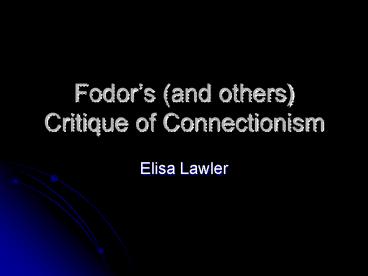Fodors and others Critique of Connectionism - PowerPoint PPT Presentation
1 / 18
Title:
Fodors and others Critique of Connectionism
Description:
... postulates a 'language of thought' (LOT) which explains these properties ... explains ... LOT explains Productivity. Separation of rules and semantics ... – PowerPoint PPT presentation
Number of Views:146
Avg rating:3.0/5.0
Title: Fodors and others Critique of Connectionism
1
Fodors (and others) Critique of Connectionism
- Elisa Lawler
2
Fodor and Pylyshyn 1988
- Necessary properties of any theory of cognition
- Systematicity
- Productivity
3
Systematicity
- John loves the girl
- The girl loves John
- you don't find people who can think the
thought that John loves the girl, but can't think
the thought that the girl loves John." (FP) "But
now if the ability to think that John loves the
girl is intrinsically connected to the ability to
think that the girl loves John, that fact will
somehow have to be explained." (FP)
4
Related thoughts have shared constituents
- Fodor (1998) writes "mental representations are
compositional, and compositionality explains
systematicity. The reason the capacity for 'John
loves Mary' thoughts implies a capacity for 'Mary
loves John' thoughts is that the two kinds of
thoughts have the same constituents ..."
5
Problem with Systematicity
- Systematicity itself is questioned
- In non-linguistic cognitive architecture (which
is shared by animals) - Capacity to think I want to eat the bird does
not imply that the same animal has the capacity
to think The bird wants to eat me - Possibly phenomenon of systematicity is actually
a result of experiences
6
Systematicity and Connectionism
- FP (1988) claim that connectionist models are
incapable of accounting for systematicity because
they lack syntactic complexity - Systematically related propositions share some
syntactic parts, therefore some sort of syntactic
representational structure must exist (they dont
in traditional connectionist networks)
7
Productivity
- Representational capacity is unbounded given
finite resources - E.g. given rules of language and words, an
infinite number of sentences can be produced - E.g. given numbers and formulas, infinite number
of computations can be executed - Connectionist models can not account for this
- Requires infinite memory capacity because there
would be an infinite number of node
combinations/patterns
8
Classical View and LOT
- Fodor claims that Classical views naturally
account for systematicity and productivity
whereas Connectionist models do not - Classical Model postulates a 'language of
thought' (LOT) which explains these properties
9
LOT
- Uses combinatorial syntax and semantics in
forming mental representations ( FP, 1988) - Example in natural language
- John loves Mary
- John, Mary loves are syntactic components
which combine (via syntax and grammar) into
sentence each word also has semantic meaning
10
LOT explains Systematicity
- If concepts are words and phrases in the LOT,
then accessing a concept is just the occurrence
of words and phrases from the LOT -gtyou can find
similarity in the constituents of 2 different
concepts (systematicity follows)
11
LOT explains Productivity
- Separation of rules and semantics allows
productivity - Linguistic competence
12
Smolenskys PTC
- "As far as I can tell, the argument has gone like
this Fodor and Pylyshyn claimed that you can't
produce a connectionist theory of systematicity.
Smolensky then replies by not producing a
connectionist theory of systematicity. Who would
have foreseen so cunning a rejoinder." (Fodor,
1991, 279)
13
Smolensky in pursuit of connectionist model that
recognized systematistic cognitive capacities
- 1) decompose target knowledge into roles and
fillers to represent lta,b,cgt ordered string, - 2) roles are position1, position2, position3
- 3) fillers represented as letters a,b,c
- 4) each role and filler get a connectionist
vectorial - representation, and role and vector are
bound - together by vector multiplication
- 5) As a result, a system can differentially
represent - ltabcgt and ltbcagt
14
Fodor rejects PTC
- Fodor claims that Smolenskys PTC is really a
disguised implementation of the Classical view,
and can not provide a completely independent
account for systematcity - Fodor calls vector products derived constituents
15
- BROWN TREE
- Given a tree, the algorithm yields a
corresponding vector given a tree, the algorithm
yields the tree from which the vector is derived - Vectors dont have constituents, but vectors can
be derived from trees, which do have constituents.
16
Changes in Belief
- If there is no way to generalize elements in one
network to another, then there is no way to embed
the same belief in different situations (The Mind
Doesnt Work That Way) - Connectionist networks can only manipulate
strength of the connections, can not change the
underlying architecture of the system
17
Other Criticisms
- Not a correct neurological representation of
brain not as complicated as real brain - But bigger nets pose problem of overwriting and
breaking down - 1st wave of Connectionist models attacked for
representing only limited/specific cognitive
tasks - Artificial input/output representations
18
Conclusions
- Fodor others have rejected Connectionist models
because they lack any independent way of
explaining systematicity and productivity - Smolenskys attempt at a Connectionist model for
systematicity was rejected by Fodor who claimed
that they fundamentally relied on Classical view
for explaiming systematicity and productivity - Brain is more complicated than any Connectionist
model - Training is based on sterile/artificial
situations which discredit validity of resulting
performance as a true cognitive model































